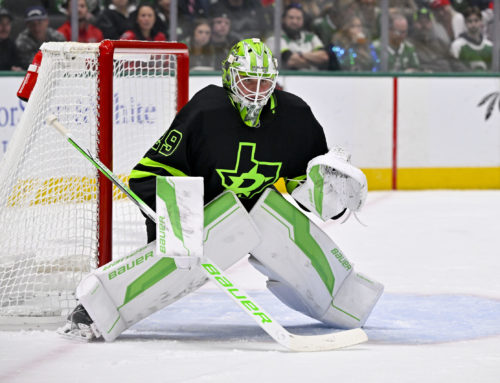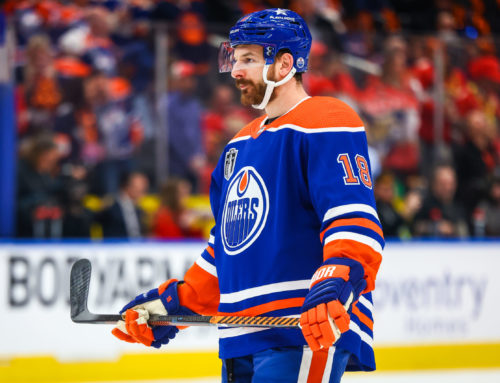Welcome to the playoff edition of Analytics Advantage. With the 2025 NHL Playoffs approaching, this two-part series will dive into four likely first-round matchups: Washington Capitals vs. Montreal Canadiens, Carolina Hurricanes vs. New Jersey Devils, Dallas Stars vs. Colorado Avalanche, and Los Angeles Kings vs. Edmonton Oilers.
In this first part, I'll break down each series by revisiting their historical playoff meetings, highlighting top performers, and analyzing each team's strengths and weaknesses using data-driven insights. I'll be focusing on key stats like expected goals for (xGF), shot volume, ice time, and scoring efficiency to help paint a clear picture of what to expect.
Washington Capitals (M1) vs Montreal Canadiens (WC2)
The last time Washington and Montreal met in the playoffs was 2010, when the top-seeded Capitals were stunned in seven games. Jaroslav Halák posted a .939 save percentage, while Mike Cammalleri and Tomáš Plekanec combined for 17 points to lead the upset. Despite strong efforts from Alex Ovechkin and Nicklas Bäckström, goaltending and timely scoring proved decisive. Fifteen years later, the question remains, can Montreal pull off another surprise?
This year, Washington enters as one of the NHL's hottest teams, riding a second-half surge under Head Coach Spencer Carbery. The Capitals are winning on the margins: strong 5v5 metrics (50.0 CF%, 57.0 GF%), disciplined play, and standout performances from Dylan Strome and Alex Ovechkin. Their edge lies in scoring depth and structure,3.55 goals for and 2.67 against per 60,backed by a 57.0 xGF% and 55.3 HDGF%. They also rank 14th on the power play (23.1%) and 7th on the penalty kill (81.5%). Aliaksei Protas should be back in time for this series, and his presence will be noticeable if he can stay healthy. The most crucial player in this series will be Logan Thompson, as he is coming off one on the best seasons of his career, and freshly injured this April. He will need to play at the same level he has all season.
Montreal, meanwhile, has impressed with a balanced attack led by Nick Suzuki, Cole Caufield, and breakout rookie Lane Hutson. But their weaker shot metrics (46.6 CF%, 48.4 xGF%) and average special teams: 20th on the power play (20.6%) and 10th on the penalty kill (80.9%). With a sub-82% high-danger save percentage and 3.17 GA/60, the Canadiens will need to tighten up defensively to keep pace with Washington's offensive pressure. The Habs have on last trick up their sleeve, which is the Ivan Demidov, who will certainly be a dynamic player, but will he be able to handle the physicality of playoff hockey?
Notable Players to Watch: Washington Capitals
• Dylan Strome (77 GP, 25 G, 51 A, 76 PTS, 17:26 TOI) – Top-line center with 3.40 P/60; reliable playmaker and offensive driver.
• Alex Ovechkin (61 GP, 42 G, 27 A, 69 PTS, 17:47 TOI) – Elite scorer; 3.82 P/60 with 225 shots and 18.7% shooting.
• Pierre-Luc Dubois (77 GP, 19 G, 44 A, 63 PTS, 17:20 TOI) – Secondary scoring threat; strong in transition and all situations.
• Tom Wilson (76 GP, 32 G, 30 A, 62 PTS, 18:47 TOI) – Physical scorer; 219 hits and versatile usage.
• John Carlson (77 GP, 5 G, 45 A, 50 PTS, 23:35 TOI) – Heavy-minute defender; key on PP with 3.64 PP P/60.
Notable Players to Watch: Montreal Canadiens
• Nick Suzuki (78 GP, 28 G, 58 A, 86 PTS, 19:56 TOI) – Two-way top center; 3.32 P/60, 31% of points on PP.
• Cole Caufield (78 GP, 37 G, 30 A, 67 PTS, 18:03 TOI) – Primary scorer; 3.85 P/60 with 229 shots.
• Lane Hutson (78 GP, 6 G, 58 A, 64 PTS, 22:39 TOI) – Rookie with elite offensive instincts; PP quarterback.
• Juraj Slafkovsky (75 GP, 17 G, 31 A, 48 PTS, 17:19 TOI) – Power winger developing into reliable top-six contributor.
• Kaiden Guhle (51 GP, 4 G, 12 A, 16 PTS, 21:12 TOI) – Defensive anchor; 115 blocks and tough matchups.
Carolina Hurricanes (M2) vs. New Jersey Devils (M3)
These two teams are no strangers in the postseason, with five playoff meetings since 2001. Carolina has historically had the edge, winning four of those series, including a 4–1 rout just last spring. In 2024–25, Carolina once again boasts the league's best penalty kill (84.9%) and ranks top-five in expected goals share (55.0 xGF%). Their disciplined structure shines at 5-on-5, where they own a 54.3 GF% and allow just 2.70 goals per game. However, the power play remains a weak spot, sitting 24th at just 18.6%.
The Devils, meanwhile, continue to be an offensive juggernaut. They sit 3rd league-wide on the power play (27.9%) and 3rd on the penalty kill (82.6%), combining strong special teams with top-tier even-strength creation. With a 52.6 xGF% and 53.1 SCF%, New Jersey generates quality looks in bunches and allows fewer high-danger chances than they give up. They've averaged 2.96 goals per game (15th) while allowing 2.64 (10th). If this series turns into a special team battle, New Jersey may finally flip the script on Carolina's postseason dominance.
Notable Players to Watch: Carolina Hurricanes
• Sebastian Aho (76 GP, 28 G, 42 A, 70 PTS, 20:10 TOI) – First-line center with 3.19 P/60; leads the team in scoring and draws top matchups.
• Seth Jarvis (70 GP, 30 G, 31 A, 61 PTS, 19:24 TOI) – Quick and opportunistic winger; career-high 30 goals and key on both special teams.
• Andrei Svechnikov (67 GP, 19 G, 26 A, 45 PTS, 17:10 TOI) – Power forward with scoring upside and strong puck protection.
• Brent Burns (77 GP, 6 G, 20 A, 26 PTS, 21:19 TOI) – Veteran blueliner with heavy usage in all situations; anchors the top pair.
• Jaccob Slavin (77 GP, 6 G, 20 A, 26 PTS, 21:35 TOI) – Defensive specialist and penalty kill anchor; often deployed against top lines.
Notable Players to Watch: New Jersey Devils
• Nico Hischier (72 GP, 35 G, 32 A, 67 PTS, 20:22 TOI) – Two-way leader and faceoff ace (55.4%); responsible for tough matchups and transition play.
• Jesper Bratt (78 GP, 21 G, 67 A, 88 PTS, 18:52 TOI) – Breakout season with team-leading 88 points; sets the pace at 5-on-5 and PP.
• Luke Hughes (68 GP, 7 G, 35 A, 42 PTS, 21:05 TOI) – Young defenseman with high-end offensive upside; plays big minutes and runs the power play.
Dallas Stars (C2) vs Colorado Avalanche (C3)
This Central Division rivalry enters another playoff chapter after a six-game series in 2023–24 when Dallas eliminated Colorado behind stellar goaltending and tight defensive structure. Historically, these teams have been evenly matched—splitting 38 postseason meetings since 1999—but the Stars have the edge in recent memory, winning last year's matchup with a 3.67 goals-per-game average.
Dallas enters as the (likely) Western Conference's second seed, combining elite scoring depth (3.42 GF/G, 4th) with sound defense (2.59 GA/G, 4th). Their special teams are strong on both sides, ranking 16th on the power play (22.9%) and 2nd on the penalty kill (83.8%), while maintaining a top-10 shot share (50.5 CF%). The addition of Mikko Rantanen (32 goals, 85 points in 78 games) has further boosted an offense already featuring Jason Robertson, Wyatt Johnston, and Roope Hintz. Matt Duchene leading the team in scoring is not something many expected at the start of the season, but it highlights just how deep this Dallas lineup truly is. Jake Oettinger is another massive advantage for the Stars, as he is at the end of an already difficult to beat defense, so the chances must be high danger and efficient to beat this team
Colorado, meanwhile, has been slightly less dominant but remains dangerous. They rank 7th in goals per game (3.34) and 8th in power-play efficiency (24.8%), with Martin Nečas (27 goals, 81 points in 76 games) joining Nathan MacKinnon and Cale Makar to drive the attack. However, defensive concerns remain: the Avs have allowed 2.78 goals against per game (14th), and their penalty kill sits just 19th at 79.5%. Their elite top-end talent can win games, but consistency and depth will be tested against a well-structured Stars team.
Notable Players to Watch: Dallas Stars
• Matt Duchene (78 GP, 30 G, 51 A, 81 PTS, 17:07 TOI) – Leads team in points; high-end efficiency with 3.64 P/60 and 20.1% shooting.
• Jason Robertson (78 GP, 34 G, 45 A, 79 PTS, 17:58 TOI) – Dynamic winger; 204 shots and key contributor on the power play.
• Mikko Rantanen (78 GP, 32 G, 53 A, 85 PTS, 21:20 TOI) – Midseason acquisition with elite scoring touch; 207 shots, 21 PPP.
• Wyatt Johnston (78 GP, 31 G, 38 A, 69 PTS, 18:59 TOI) – Breakout year as a two-way center; 16.0% shooting on 194 shots.
• Thomas Harley (76 GP, 16 G, 34 A, 50 PTS, 23:22 TOI) – Anchors top pair; logging heavy minutes and drives offense from the back end.
Notable Players to Watch: Colorado Avalanche
• Nathan MacKinnon (79 GP, 32 G, 84 A, 116 PTS, 22:46 TOI) – MVP candidate; drives possession and leads team in both points and TOI.
• Martin Nečas (76 GP, 27 G, 54 A, 81 PTS, 18:59 TOI) – Trade deadline pickup; 193 shots and 24 power-play points.
• Cale Makar (79 GP, 30 G, 61 A, 91 PTS, 25:42 TOI) – Elite offensive defenseman; 12.3% shooting and 3.70 P/60.
• Artturi Lehkonen (67 GP, 27 G, 17 A, 44 PTS, 20:27 TOI) – Versatile top-six winger; strong even-strength scoring with 25 ESG.
• Devon Toews (75 GP, 9 G, 34 A, 43 PTS, 24:36 TOI) – Defensive backbone; plays top-pair minutes and chips in offensively.
Los Angeles Kings (P2) vs Edmonton Oilers (P3)
A classic Pacific Division rivalry continues. This will mark the fourth straight postseason meeting between Edmonton and Los Angeles and the 11th all-time. The Oilers have won three in a row and six of the previous 10 series, including last year's 4–1 victory. Historically, Edmonton has outscored LA 228–177 in playoff games, driven by elite offensive talent that continues today.
In 2024–25, Edmonton once again leans on its high-powered top six. The Oilers rank 11th in the league with 3.17 goals per game and feature the 9th-best power play (24.6%). At even strength, their 52.2% expected goals share and 53.7% high-danger shot share highlight their ability to generate quality looks. But defensive issues linger as they allow 2.91 goals against per game and their penalty kill is just 17th (77.9%). Goaltending is the biggest question that oilers fans will have coming into this post season, as Stuart Skinner has not looked his best this year.
Los Angeles counters with a disciplined, two-way structure under Jim Hiller. They allow the second-fewest goals per game (2.44), backed by strong 5v5 defense and a .904 team save percentage. Their power play (15.9%) remains a weakness, but they rank 5th on the penalty kill (81.7%) and win the shot share battle consistently (52.7 CF%). If they can limit Edmonton's stars at even strength, the Kings have the depth and structure to grind out another long series. They also have been dominant at home this season, so being the higher seed is crucial for the Kings to slay the Oilers for the first time in a long time.
Notable Players to Watch: Edmonton Oilers
• Leon Draisaitl (71 GP, 52 G, 54 A, 106 PTS, 21:31 TOI) – Offensive centerpiece; ranks top-five league-wide in points/60 (4.16) with elite power-play production.
• Connor McDavid (63 GP, 26 G, 64 A, 90 PTS, 22:08 TOI) – Still one of the best creators in the game; 3.87 points/60 and leads the team in even-strength assists.
• Evan Bouchard (77 GP, 13 G, 50 A, 63 PTS, 23:19 TOI) – Power-play quarterback; ranks 2nd among defensemen in power-play points/60 (5.52).
• Zach Hyman (71 GP, 27 G, 17 A, 44 PTS, 19:04 TOI) – Net-front specialist with 21 even-strength goals and seven game-winners.
• Ryan Nugent-Hopkins (76 GP, 20 G, 29 A, 49 PTS, 19:01 TOI) – Secondary scoring and key on special teams; 20 power-play points.
Notable Players to Watch: Los Angeles Kings
• Adrian Kempe (77 GP, 33 G, 31 A, 64 PTS, 19:11 TOI) – Primary scorer with 2.60 points/60 and 25 even-strength goals.
• Anze Kopitar (77 GP, 19 G, 43 A, 62 PTS, 18:58 TOI) – Veteran two-way leader; 56.9% on faceoffs and leads all LA forwards in TOI.
• Kevin Fiala (76 GP, 30 G, 22 A, 52 PTS, 18:33 TOI) – Dynamic transition threat; leads team in PP goals (10) and shots.
• Quinton Byfield (77 GP, 20 G, 28 A, 48 PTS, 18:35 TOI) – Breakout campaign; combines size, speed, and 43 even-strength points.
• Drew Doughty (28 GP, 4 G, 13 A, 17 PTS, 24:17 TOI) – Logging heavy minutes again; still controls pace and drives transition.
With each series bringing its own strengths, weaknesses, and X-factors, the first round promises to be one of the most competitive in years. Part Two will cover the remaining matchup as playoff seeding solidifies.
Stay Connected
For personalized advice or more in-depth analysis:
• Twitter/X: @DH_staspup
• Email: staspup@proton.me
• Bluesky: stasp.bsky.social
Data Sources: QuantHockey, StatHead, Hockey-Reference, Natural Stat Trick
One Comment
Leave A Comment
You must be logged in to post a comment.





 BUF
BUF NYR
NYR CHI
CHI WSH
WSH CBJ
CBJ S.J
S.J VAN
VAN ANA
ANA

Great analysis. Will you do the other teams soon?